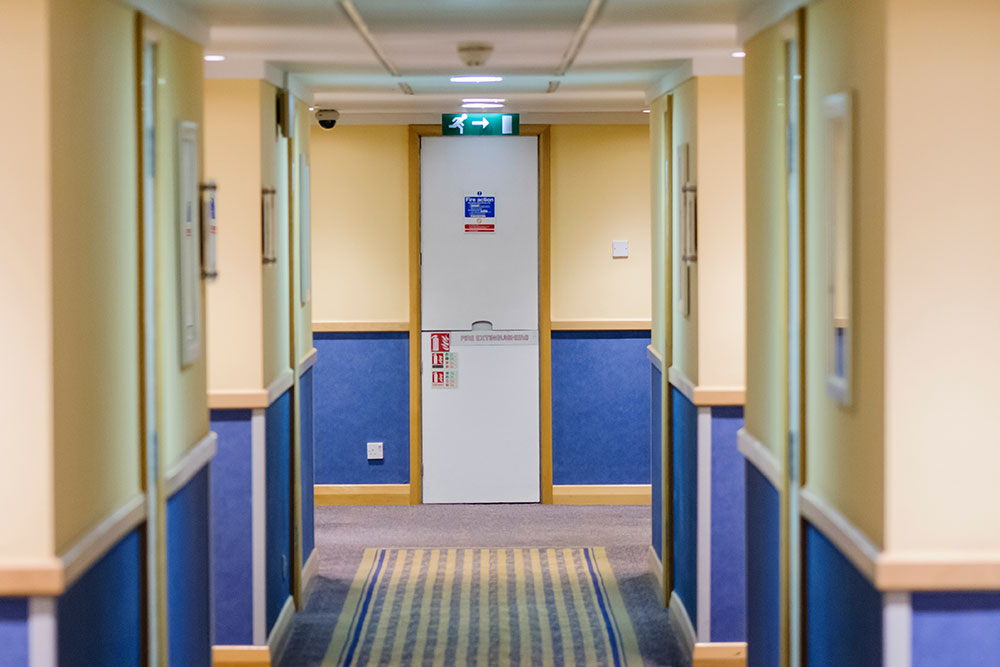
Buildings should be divided into separate fire-resistant sections or compartments. If a fire starts in one compartment, it will be contained, giving people more time to escape. Dividing buildings this way with fire safety in mind is fire compartmentation.
This blog provides an overview of how fire compartmentation works, the relevant regulations and ways it’s used to protect people and property. It also looks at how fire doors and fire stopping contribute to comprehensive fire protection.
Key Takeaways
- Fire compartmentation divides buildings into fire-resistant sections to contain fire, smoke and heat for a set period.
- Fire doors and fire stopping are essential components of fire compartmentation, helping to prevent the spread of fire between compartments.
- Fire compartmentation is required under the Regulatory Reform (Fire Safety) Order 2005 and the Building Regulations 2010.
- Maintenance and regular inspections of fire doors, as well as fire stopping and compartmentation measures, are necessary to ensure compliance.
Fire Compartmentation Explained
Fire compartmentation is a method of dividing buildings into separate fire-resistant compartments.
Compartments are made using fire-resistant materials for walls, floors and ceilings. If a fire breaks out in one, the flames, heat and smoke should be contained for between 30 to 120 minutes, depending on the fire-resistant materials used.
This delay gives people more time to escape and allows emergency services to arrive and take control of the situation before the fire spreads. Compartmentation also concentrates fire damage in one section of a building to protect other areas.
The Difference Between Fire Compartmentation and Separation
Fire compartmentation and fire separation are closely linked.
Fire separation refers to the physical barriers that prevent fire and smoke from passing between different areas.
Fire compartmentation takes this further by ensuring that fire is contained for a set period.
Fire Safety Training
Our Fire Safety Training course gives a basic understanding of fire prevention principles, the sources of ignition and fuel and safe systems of work to prevent fire hazards and accidents within the work environment.
Fire Compartmentation Regulations
Two key regulations relate to fire compartmentation: the Regulatory Reform (Fire Safety) Order 2005 and the Building Regulations 2010
The Regulatory Reform (Fire Safety) Order 2005
The Regulatory Reform (Fire Safety) Order 2005 is the primary fire safety legislation for non-domestic properties in England and Wales.
It requires a “responsible person” to ensure fire safety for their premises. Their first and most important duty is carrying out a fire risk assessment to identify fire hazards and mitigate risks, which includes the use of fire compartmentation.
The Building Regulations 2010
The Building Regulations 2010 (specifically Schedule 1, Part B) set out fire safety specifics. According to these regulations, buildings must be designed and constructed to limit the spread of fire between different compartments.
Key duties and requirements under the Building Regulations 2010 relating to fire compartmentation include:
- Compartmentation in multi-storey buildings: Each storey must be divided into fire-resistant compartments to prevent the vertical spread of fire.
- Protected escape routes: Fire compartments must protect escape routes so people can safely evacuate without being exposed to fire or smoke.
- Common walls between buildings: Any walls that are shared by two or more buildings must be fire-resistant. They should extend to the full height of the building and be capable of preventing the spread of fire between different premises.
- Fire-resistant materials: Walls, floors and ceilings used in compartmentation must be constructed from fire-resistant materials capable of containing fire for the required time (typically 30, 60 or 120 minutes, depending on the building).
- Control of fire spread through voids: Any voids (such as cavities in walls or ceilings) must be protected with fire-stopping measures to prevent the spread of fire through hidden spaces.
- Service penetrations: Openings for electrical, plumbing and HVAC systems that pass through fire-resistant compartments must be sealed with fire-resistant materials to maintain the integrity of the compartment.
Fire Compartmentation Examples
Multi-Residential Buildings
In multi-residential buildings, each flat should be designed as its own fire compartment. If a fire starts in one unit, it should be contained, preventing the spread of flames and smoke to neighbouring homes or shared spaces like corridors and stairwells.
This approach allows residents more time to evacuate or to stay put in relative safety while emergency services tackle the fire (a strategy known as “defend in place”). It also limits the overall fire damage to a single flat, reducing the potential impact on the entire building.
Hospitals
Traditional evacuation strategies aren’t suitable for most hospitals. They’re typically large, complex and filled with hundreds of workers, visitors and patients. And most patients can’t be moved easily, making a full-scale evacuation unrealistic.
Dividing a hospital into fire compartments solves this problem and lets staff implement more practical fire evacuation strategies. These strategies often involve keeping patients safe by moving them horizontally from one fire compartment to another rather than immediately evacuating them from the building.
Offices
In office buildings, fire compartmentation helps protect assets and maintain business continuity in the event of a fire.
Similar to other buildings, different sections of the office are divided into fire-resistant compartments to limit the spread of flames. However, offices often house high-value assets, such as servers, data centres and essential documents. Fire compartments around these assets may use higher-rated fire-resistant materials to ensure the contents survive a fire unscathed.

Fire Compartmentation and Fire Stopping
Fire compartments can be compromised by gaps or openings that allow fire and smoke to spread between sections of a building. These openings are often created by service penetrations – holes made for pipes, ducts and electrical cables to pass through.
Fire stopping is one solution to this problem. It involves sealing any gaps or penetrations with fire-resistant materials, such as sealants, boards or collars. By closing off these vulnerable points, fire stopping helps maintain the integrity of the fire compartments.
Fire Compartmentation and Fire Doors
Fire doors help maintain the integrity of fire compartments by protecting escape routes, stairwells and corridors. When closed, they create a barrier that prevents fire from spreading into adjoining compartments, giving people more time to evacuate safely.
Fire doors must be properly maintained and regularly inspected to be effective (this is another duty for the “responsible person”). Any damage to the door, its frame or its closing mechanism can compromise its ability to withstand fire. Additionally, fire doors must never be propped open, as this renders them completely ineffective.
Fire Safety Courses
Effective fire compartmentation is critical for ensuring building safety and compliance. But for it to work, all elements – such as fire stopping and fire doors – must be properly installed, maintained and regularly inspected.
We offer a range of online Fire Safety Courses designed to help you stay compliant and ensure that your fire safety measures are up to standard.
Our courses cover essential topics like fire stopping and fire door inspection, giving you the knowledge and skills needed to ensure your fire safety measures are effective and compliant.





















